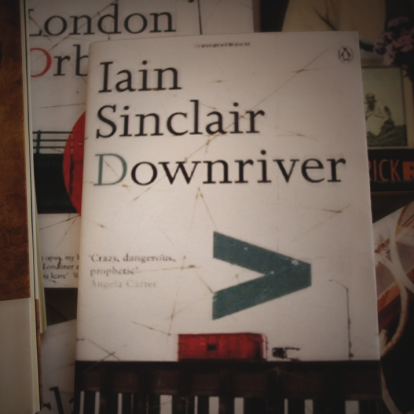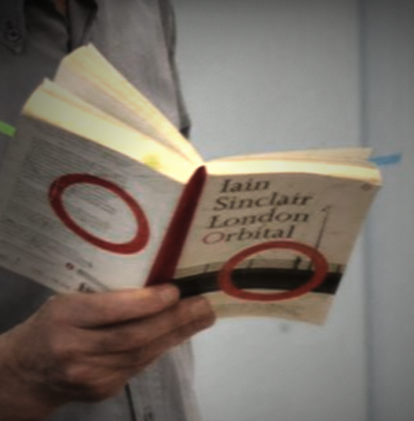This was never the world-place for Sebald. Conversation between Bruno Galindo and Iain Sinclair.
06 .04 .2015 - Bruno Galindo & Iain Sinclair
Born in Wales in 1943, a year before Sebald, Iain Sinclair has written a series of books exploring the themes and territories that are now considered the cornerstones of Sebald’s project. Years before the author of Austerlitz reached the height of his popularity, Sinclair had already brought an encyclopaedic breadth to some of his finest books, together with a concern to recover forgotten history and the aesthetic of the flâneur in the city. In the short conversation we are presenting here, the writer and journalist Bruno Galindo takes Sinclair’s work as a starting point in order to follow the traces of W.G. Sebald in one of the most interesting examples of English prose of the past few decades.

Iain Sinclair (Re-photo) / SEBALDIANA [cc]
Bruno Galindo: Please let me start our conversation with the unavoidable basics questions: your first Sebald readings and your discovery of Austerlitz. How, where, when?
Iain Sinclair: I heard about The Emigrants pretty soon after it was published in England in 1992. I read it and was especially taken with passages set in East London. Here was a fresh take on territory that I was familiar with and had struggled to write about over many years. Sebald, it appears, was a spectre of the same streets, He travelled, quietly and mysteriously, along parallel lines, within shadows that we sometimes shared. In May 2000, a poet and art curator called Ian Hunt published an essay called Intoxicant Flashbacks, as part of a collection from the Camberwell Press called Lost Horizons. Hunt’s investigation linked my novel White Chappell, Scarlet Tracings with Sebald’s The Rings of Saturn. “Both write out of landscape,” Hunt said. “Out of place, with degrees of intensity so far beyond any set-dresser’s notion of research that their books have in subtle and significant ways enlarged the scope of fiction from within”. Around this time, I moved my publishers from Granta to Hamish Hamilton. My new editor Simon Prosser was a Sebald enthusiast. And he was about to become Sebald’s publisher too. He gave me one of the special signed proof copies of Austerlitz. It became the Sebald book in which I felt most deeply implicated: by way of the Welsh back story and, more vividly, the fugitive tracings across Whitechapel and Bow. When the time came, I followed up that interest by writing a chapter for a book called American Smoke, in which I walked with Sebald’s friend Stephen Watts. This chapter was subsequently edited out. It became a stand-alone item published by Test Centre.
B.G.: You’ve explained your interest for Sebald identificating the writer with the walker. Do you keep that same interest on the author? Are there any other hidden, more obscure characteristics of his persona that captivates you?
I.S.: The more I read, the more anecdotes I heard from friends and acquaintances of Sebald, the more intriguing he became. There does seem to be a puzzle here, as with anyone who writes with such meticulous care in such a coded fashion, offering and withholding at the same time. How much was the style the man? I felt like returning, at regular intervals, to my own revisions of the story. The business is unfinished.
B.G.: I read at The Guardian that you once had a contact with Sebald himself… in an elevator. I wonder how do you recall that, mmm, trip.
I.S.: I came out of the BBC in Portland Place, after doing some radio programme, and found myself sharing a lift with Sebald and his publicist. He was, with obvious reluctance, promoting Austerlitz. I’d read that morning that he was only prepared to give one interview or one talk. Now the publicist explained his full diary of events. He was being shuffled from interview to interview. Which probably explained why he struck me as just about the most melancholy presence I’d ever come across. Perhaps it was the moustache…
B.G.: You followed Sebald’s footsteps in british lands and wrote about the experience; first as part of American Smoke: Journeys to the End of the Light; then as a whole-piece short book. For those how have not read that one, can you describe it, or maybe spot the interesting parts of the experience?
I.S.: American Smoke is a memory book, an expedition through the topography of early influences (especially the Americans). And a raid on future memories too. The mood is one of elective exile, getting away from the London Olympics, the enclosures and land piracy in the Lower Lea Valley. The book is a documentary fiction, moving characters and sometimes inventing them to suit the shape I want to construct. The Sebald chapter was intended to operate as a demonstration of my method and also a refracted farewell to territory I was leaving behind. In the end, I decided that I couldn’t afford that detour (in a book made from detours).
B.G.: I wonder how much are you into mithomania, in the cult-of-personality towards your referencial authors. Do you adore your favourite authors in such a way? Have you tracked others like Sebald (I think of Olson and Kerouac), travelled just to see where they lived or died, or worked in other emotional maps?
I.S.: My work is all myth. As Blake (almost) said, you have to construct your own myths or be enslaved by those of other men. London is stitched from echoes of previous writers: Blake, De Quincey, Dickens, Conrad, Eliot (and now Sebald). Our task is to re-activate those radio signals, to make quotation original. To steal from the richest sources.
B.G.: These are, we could say, re-enactments. I find interesting the ritual repetitions of the same things or even somebody else’s routine; whether they may or may not have a very clear sense. I would say there’s a fascination there. Do you agree?
I.S.: I’m not sure that there are any re-enactments. Re-enactments belong with the heritage industry, outside Buckingham Palace or the Tower of London. Or folk in period costume still fighting the English Civil War. I do believe in re-engagement. And daily walks that re-assert a pattern, thereby bringing the pattern to life for another day. It is one of the great flaws in Sebald appreciation, I feel, that people try to literally re-enact the route outlined in that persuasive fiction, The Rings of Saturn. An expedition that only exists as it is written.

Downriver / SEBALDIANA [cc]
B.G.: I remember travelling from Madrid to Paris by train: always arriving around 8AM in Gare d’Austerlitz, then having breakfast always at the same café, crossing the Jardin des Plantes through the same paths, reaching the arab quarter at rue Jussieu… That service is over since last year due to a new speed train route. Do you have that kind of nostalgia that make of us “citizens of the past”? How do you deal with that status (if you feel part of it)?
I.S.: We are citizens of a past from which we have been banished. And a future to which we are not qualified to gain admittance.
B.G.: If the low cost and preyihad era helped us occidental citizens feel —I’ll be ironic on this— “citizens of the world”, has the postcapitalism times, with its airports and shopping centers and olimpic arquitecture, turned us —I’ll be ballardian now— “citizens of no-places”.
I.S.: Being, as you suggest, ‘citizens of no place’, is the contemporary fix. But not necessarily a disadvantage. It looks like the portal to Virtual World, Second Life, game-show avatars of nothing and nowhere. Or anywhere and everywhere. But not for me. Not for Sebald with his crafted notebooks, his worked-over photographs, and his slow train trips towards deserted nocturnal railway stations.
B.G.: Tell me about your relationship with Stephen Watts, poet and Sebald’s friend, and his importance in your walks tracking the writer.
I.S.: Stephen is like a living ghost liberated from Sebald’s fiction, and granted a richly posthumous existence, as he continues to bear witness to the truth. Of course he is also a notable poet of place. As he was before he met Sebald. He is a modest man, a wanderer, who comes alive when he reads his own poetry or a passage from Austerlitz.
B.G.: You tracked Sebald, the reader of Tracking Sebald tracked you tracking Sebald and somebody inspired by that will re-enact both your experiences, invocking the shade of that past experiences in the same streets. How will that streets evolve in the next years?
I. S.: This non-interview, like the act of leaving postcards in a box where nobody will ever find them, is part of some unfinished paranoid novel of tracking the trackers through labyrinthine surveillance cities where every inhabitant is so closely watched that nothing attempted can achieve any traction. This was never the world-place for Sebald. And he succeeded in avoiding it. While contributing texts that will be provocative and inspiration for many years.
Madrid-Hackney, january 2015






